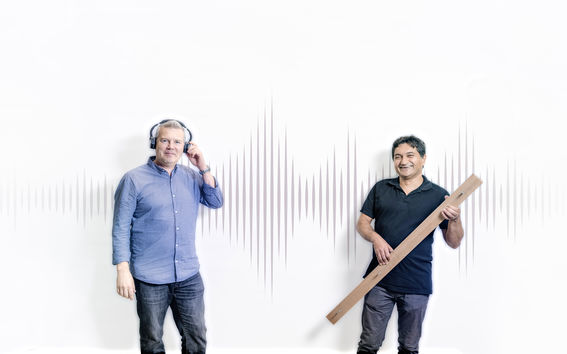Ironing tunes

When an international group of experts came to evaluate Aalto University’s research and artistic activities one year ago, Academy of Finland Research Fellow Koray Tahiroğlu played them some ironing music.
Tahiroğlu’s student had crafted a unique instrument by combining a computer with a clothes iron and an ironing board during the course he was teaching physical interaction design. An infrared scanner on the iron recognises different colour hues on the board, then transfers the data to the computer, which processes the hues into musical melodies.
Sounds fun, but Tahiroğlu, who leads the Sound and Physical Interaction research group, and Professor of Audio Signal Processing Vesa Välimäki say a bigger idea is at stake.
‘Everybody likes music. We want everyone to also enjoy the opportunity of playing it,’ says Välimäki.
Teaches language and nurtures the mind
Hearing is one of our most nimble senses, and music triggers emotional responses faster than any other art form. Just waiting for the best part of our favourite song makes the brain release dopamine, the neurotransmitter of satisfaction.
But music affects a lot of other things besides emotions. Research indicates that it refreshes memory, boosts concentration and speeds up language learning, for example. Music benefits especially those who themselves practice it. The younger you get started, the better, but the brain benefits also from musical activity that starts in adulthood.
Vesa Välimäki started playing the piano and flute as a child and got into synthesisers when at school. He seriously considered a career in music before deciding to study for a master’s in engineering because this enabled him to simultaneously immerse himself in acoustics. Koray Tahiroğlu played in bands, studied to become an architect in Istanbul and experienced an awakening when he got the opportunity to work with the available digital technologies at the time in a team and together they developed one of the first virtual museums on the internet in 1995, Istanbul Museum of Painting and Sculpture.
‘Getting to digitally do things that would have never been possible before was a turning point in my career.’
Now, Välimäki and Tahiroğlu both are part of Aalto Acoustics Lab, a multidisciplinary research centre that brings together researchers, teachers and students from the departments of Signal Processing and Acoustics, Computer Science, and Media.
Välimäki specialises in, among other things, developing earphone and speaker sound quality as well as virtual audio technology, for example modelling and encoding Jimi Hendrix’s guitar sound. Tahiroğlu studies the interaction between music, technology and people. At present, the pair is coming up with ideas for new instruments – details on which they are not yet ready to divulge.
Learning to play traditional instruments often demands lots of motivation and diligent practise. Although all of us are gifted at birth with an ability to understand music, many don’t even try creating it themselves, fearing that they have no sense of rhythm or singing skills.
‘With help from a computer, touching nearly any object can make it play. A vase might sound like a drum or a symphony orchestra,’ Välimäki says.
‘Everyone knows how to use a phone or a clothes iron, so why couldn’t these things be refined into instruments? We want to provide people with the means to produce something beautiful with real world physical interactions,’ says Tahiroğlu.
Decibels and hertz
What something sounds like depends on the sound, the space and the listener.
As a physiological process, hearing is straightforward: the ear translates sound waves into electrical nerve cell signals that are conveyed to be interpreted by the auditory cortex, and often also to the limbic system, which regulates emotional responses.
Sound waves have a frequency that is measured in units called hertz. The more the waves vibrate, the higher the pitch of the sound heard. At best, humans are capable of hearing sounds ranging from 20 to 20 000 hertz, but sounds at the upper end of the range are often experienced as disturbing, even painful.
‘Our brains are mostly tuned to the frequency range of the human voice, which is why we find high, screeching sounds unpleasant,’ Tahiroğlu explains.
Sound intensity levels are measured in decibels. If sound intensity increases by 10 decibels, a person experiences a doubling in loudness. Tree leaves rustle at 10 decibels and a loud conversation can reach 70 decibels, while a rock concert’s typical 85-decibel loudness already breaches the noise level. Sounds louder than a 120 decibels are immediately hazardous to our hearing.
‘Noise is a major problem globally, it erodes wellbeing and causes significant health hazards ranging from stress to tinnitus. This is why you should shield yourself from it with all possible means,’ says Vesa Välimäki.
‘Earphones are a good idea in many cases, but they must be of a suitable type. Earbuds are the worst. Our measurements have shown that the intensity of background noise can actually increase when using them.’
Good echo, bad echo
Acoustics design can have an enormous impact on how sounds are heard indoors. Put concisely, it is a question of echo management, which, in offices and classrooms, for example, can be done with the aid of acoustic boards, carpets and textiles. One space is rarely suitable for everyone, which is why a musician’s dream can be a speaker’s nightmare. Välimäki has personal experience of this.
‘My flute never played as beautifully as it did at my aunt’s wedding in a handsomely resonant church in the Turku archipelago. On the other hand, I’m sure the majority of the guests couldn’t make out a word of the priest’s oration.’
How sound makes us feel is very individual. The sounds of nature often place highly on lists of our favourite sounds, but quite surprising sounds can touch us, too. In 2011, a year of record snowfall, the City of Helsinki stacked huge piles of snow on Senate Square, where tunnels were formed.
‘The thick snow blocked the sounds of the city, making it very quiet inside the tunnel,’ Tahiroğlu recalls.
The researchers’ favourite sounds are found closer to home, however. For Vesa Välimäki, it is his cat purring.
‘There’s something so sweet about it, especially when you stroke a purring cat and can feel its body vibrate.’
For Koray Tahiroğlu, the sound of his baby’s heartbeat comes tops.
‘I recorded the fetal heartbeat during my wife’s pregnancy. The pulse was rapid, about 150 beats per minute, but the rhythm was uneven, it had its own variations. I used the original recorded sound as part of the musical structure I developed on that beat in my live-electronics performances in 2010.’
Text: Minna Hölttä. Photo: Jaakko Kahilaniemi.
This article is published in the Aalto University Magazine issue 25, October 2019.
- Published:
- Updated:
Read more news

Four new Professors appointed in the School of Engineering
Professors of Practice Katja Tähtinen and Assistant Professors Jan Akmal, Magda Posani, and Jenni Partanen were appointed to the career path of professors during August-October 2024.
Call for doctoral student tutors, January 2025
Sign-up to be a tutor for new doctoral students as part of the Aalto Doctoral Orientation Days!
Aalto computer scientists in TCC 2024
Department of Computer Science paper accepted to the Theory of Cryptography Conference.